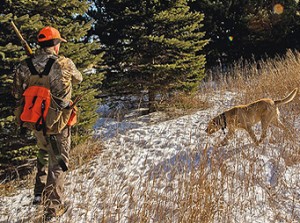The Well-Equipped Hunter
258 – April 2019
BY CHRIS ROBINSON
 Ordinarily, my monthly contribution to The Canine Chronicle contains some element of humor, is reflective or rueful, and occasionally it expresses outrage. In a major departure from the usual, this one’s going to contain some practical information–since this is the Sporting Dog issue–for those of you who are planning to take your champion sporting dogs into the field and will deal with what the well-equipped hunter and his/her dog need for field work.
Ordinarily, my monthly contribution to The Canine Chronicle contains some element of humor, is reflective or rueful, and occasionally it expresses outrage. In a major departure from the usual, this one’s going to contain some practical information–since this is the Sporting Dog issue–for those of you who are planning to take your champion sporting dogs into the field and will deal with what the well-equipped hunter and his/her dog need for field work.
SHOTGUNS
Your most important piece of equipment, and the most expensive, is your shotgun. When you start to talk about shotguns with hunters, religion and politics are non-controversial. Every hunter I’ve ever known had a set-in-stone opinion of the perfect shotgun and all were correct. A good shotgun is one with which you can consistently hit birds, that feels comfortable when you shoulder it, and it doesn’t matter if it’s a bargain single-shot or something that cost half the national debt. Also, a lot depends on what kind of hunting you want to do.
My personal preference is Browning shotguns because they fit me best, but Winchester, Remington, Benelli, Beretta, Mossberg, and dozens of other manufacturers also have their devotees within the hunting fraternity/sorority and all are fine firearms. In fact, any one of them is the perfect shotgun if you can hit birds with it. The “perfect” waterfowl shotgun for me happens to be a 12 gauge gas-operated, semi-autoloading Gold Hunter, and my “perfect” upland shotgun is an over/under 20 gauge Citori. But, a lot of hunters, either by preference or budget constraints, have only one shotgun which they use for every type of bird that they hunt. So, how do you find that illusive “perfect” shotgun or, if you de- cide you can afford two, shotguns for you?
First, you need to decide whether you plan to mainly hunt waterfowl or upland birds. Then, you need to decide what sort of action the gun has that will best fit your needs and, quite frankly, your body, your shooting skills, and your personality. When it comes to your choice of action, you have four options–single shot, pump action, semi-automatic, or double-barrel. Single shots, as the name implies, only hold one shell at a time which means you have to open the breech and insert a new shell for every shot you take. This definitely slows down the
number of shots you can take and requires you to be a pretty good wingshot if you are going to get anything on the ground for your dog to fetch. However, they are the least expensive. Pumps, which require you to “pump” a slide to load a live round and eject the spent shells, are the most common. They are relatively inexpensive, reliable, and easy to use. Semi-automatics don’t have a pump. They use gas blowback to work the action, and they are the kindest to your shoulder in terms of easing the recoil. They let you fire quicker than a pump because all you have to do is pull the trigger, but they are also more expensive and are not as reliable as a pump. The fourth option is a double-barrel. These come with the barrels either side-by-side or with one barrel over the other. These are extremely reliable, but they are also very expensive, plus, you only get two shots.
258 – April 2019
Short URL: http://caninechronicle.com/?p=161190
Comments are closed











